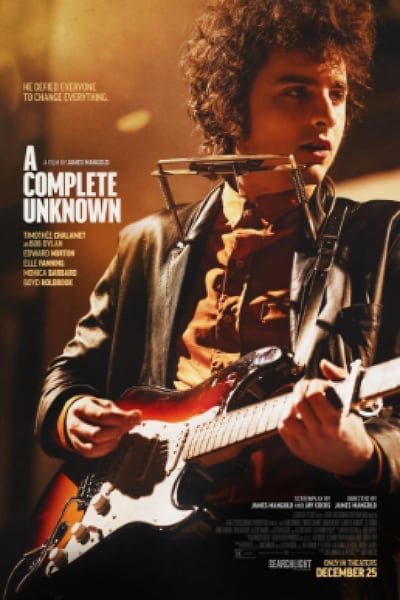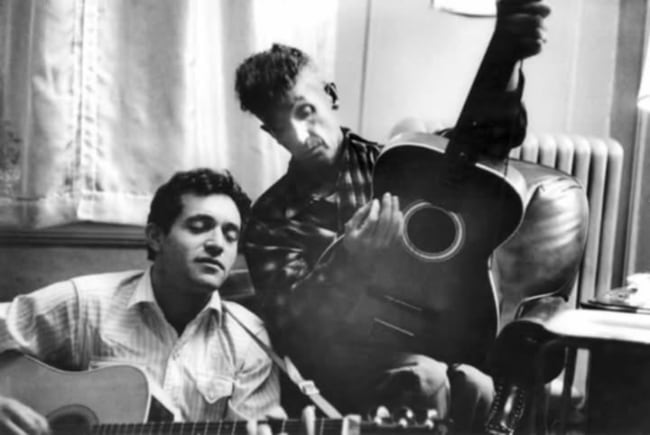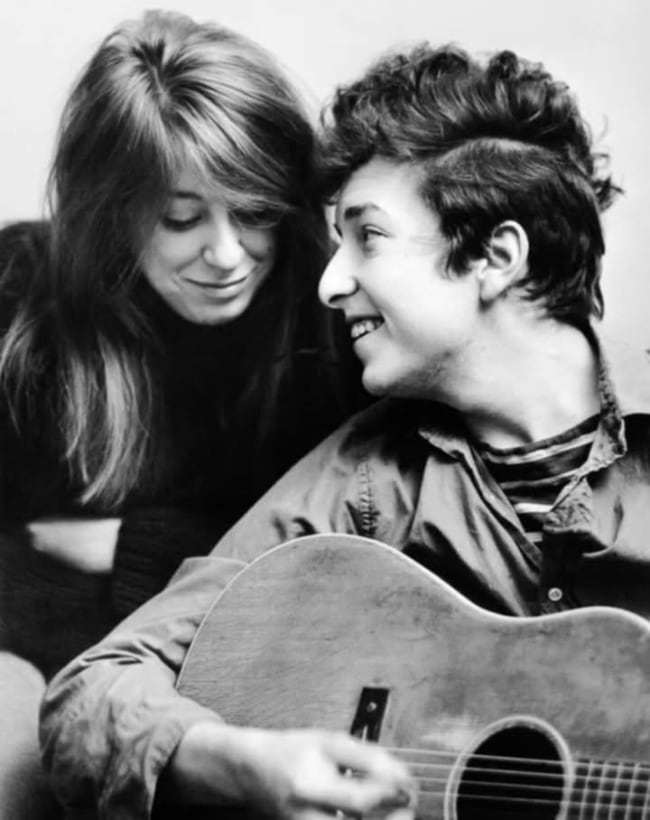 "A Complete Unknown"
"A Complete Unknown"
Directed by James Mangold
Screenplay by James Mangold and Jay Cocks
New York City was Ground Zero for many of the significant 20th Century cultural upheavals, notable events and musical movements that exploded over the course of a few decades.
The late '40s brought on The Beat Generation of William Burroughs and Gregory Corso. The smoky jazz clubs spawned Dizzy Gillespie, Miles Davis, Charlie Parker and later John Coltrane who were smashing down the walls down and redefining music, in particular jazz.
A bit over two decades later, Max's Kansas City and CBGB gave rise to Patti Smith, Blondie, Ramones and Television, off the back of The Factory scene with the Velvet Underground.
It was late 1950's that birthed a folk movement in small coffee shops in and around New York City's East Village, with characters like Rambling Jack Elliott and Pete Seeger. Accoustic folk music, with its roots with The Carter Family and acoustic blues from the cottonfields and The Dustbowl, took root with intellectuals and hip kids from inner-city university campuses. The songs became anthems for the labour movement and civil rights activists - In particular the music of Woody Guthrie.
The USA was exploding with a new sense of wildness and free thinking embodied in new art movements. It was also a time when classic older bluesman like Son House and John lee Hooker, ignored and working hand-to-mouth shit jobs, were discovered by a new hip, young and white audience.
This was the world of a 19 -year- old kid from a small rust belt town with an obsession with Woody Guthrie who found himself transplanted to NYC. Within weeks, Robert Zimmerman would change his name to Bob Dylan. With a knapsack on his back and a copy of Jack Kerouac's "On The Road" in his back pocket, Dylan and his beat-up Gibson acoustic arrived in Manhattan, due to boredom that made him skip classes in his English Lit major at University of Minnesota. He wanted to reinvent himself.
Dylan was a teenager who moved away from a love of rock n roll. It had lost its coolness and he'd read Alan Ginsberg and Herman Hess. His new obsession was folk, which he saw as the music of working-class America.
Thousands of other music-obsessed kids were listening to crystal radio sets late at night all across America, tuning in to the faint sounds of Leadbelly and old blues records by Blind Willie McTell and Robert Johnston. Then there was the uncrowned country music king, Hank Williams, and emerging labels like Folkways.
This is the world that "A Complete Unknown" takes us to, one of hustlers and activists that it visually captures sensationally well. It was a world I imagined myself in when I first visisted NYC, walking around The Village and Washington Square and retracing the streets on which Dylan walked years before amid the hustle and bustle of artists and students. The ghosts were still there when I visited. The movie is visually everything I imagined it was like in the early '60s.
The film was in production for a few years, held up by COVID and a writers' strike. Stills of when it was a work in progress were leaked to all the Dylanologist Facebook pages. I have to admit I was anticipating its release for a year, and saw it the day it released in Australia.
I was astounded by the opening 20 minutes and how well it captured the Village of 1961. The buildings, the fashion, and vibe. The cinematography by Phedron Papamicheal is mind-blowing and James Mangold's technical direction cannot be faulted. It is a beautiful looking movie.
Lead actor Timothee Chamalet took on one of the most difficult characters in music history. He needed to be subtle to capture Dylan's quirks and it could had easily turned into a Hollywood caricature. I feel his early Dylan interpretation was damned close to the mark.
Dylan himself could switch from being charming and Charlie Chaplin-like (another idol of his) when underlying this was a personality that was shy and awkward. He could certainly be intense and capable of being even more of a little prick with more than a touch of the arrogance of youth, especially when drunk. But let's face it: Bob was only 20-years-old when he arrived in a very adult world and it must have been scary at times.
Monica Barbaro is the scene-stealer with her portrayal of Joan Baez and is feisty, street smart and powerful in her interpretation. Barabaro's background is one of a ballet dancer who took acting lessons while at University of New York – ironically, a few blocks from The Village.
Monica dedicated almost four years to the role and spent many hours learning how to play guitar and sing. Her vocals are stunning. It is impossible for most established singers to capture the crystal purity of the soprano voice of Baez. It will be l stunning if there isn't an Academy Award in this performance.
All the performances are solid with Ed Norton as Pete Seeger and Boyd Holbrook as Johnny Cash. Even though the script let her down, Elle Fanning shines in the role loosely based on Dylan's girlfriend, Suze Rotolo, The movie is stunning to watch with strong characters and some classic scriptwriting and deserves all the technical awards that comes its way as a film.
As a historical document, however, the movie is a piece of crap. It is so off the mark that at times that it resembles a Mills and Boon novel with Walt Disney overtones.
The burning question is: 'Where was Rambling Jack Elliott?' It was Elliott who was at the hospital visiting Woody Guthrie whenever Bob visited – not Pete Seeger. In fact, it was in the hospital that Elliot would teach Dylan those Guthrie songs. I talked to Elliott myself when he toured, so that the story came from the man himself, and it is also documented in several biographies.
Jack Elliott was a decade older than Dylan. I did ask what Woody was like as they'd hung out together a lot in the early and mid 1950s. He said: "He lit up the room with a glow" and it was tragic to all around Woody as he succumbed to illness.
 Rambling Jack Elliott and Woody Guthrie.
Rambling Jack Elliott and Woody Guthrie.
Elliott himself had taken the Woody Guthrie schtick to Europe and found cult success at the time of Dylan coming to NYC. He'd been touring and putting albums for years and was a central character in the Village folk scene This is not first time I have seen him wiped from history.
Pete Seeger has stated many times that he never tried to pull the plug on Dylan at the Newport Folk Festival and did not have any issue with his electric performance. Muddy Waters had also performed electric at the festival. The issue for Dylan was that the PA could not cope with his volume.
Another issue: Dylan was at first infatuated with Mimi Baez, the 17- year-old younger sister of Joan. This dynamic was completely ignored. As the time, Joan was not sharing stages with Dylan at coffee shops. By 1962, Joan Baez was a major star playing concert halls. Dylan's affair with Joan occurred many months after Suze Rotolo had left for Italy.
Johnny Cash was not at the 1965 Newport Folk Festival. That whole premise and storyline is simply rubbish. The real story is actually more interesting. It was not the second album, "Freewheelin' Bob Dylan", that Cash heard and championed. it was the debut album he fell for – and it had failed commercially and initially sold only 2000 copies. Dylan was on the verge of being dropped. Cash intervened and wrote to the CBS label heads to ask them to give Dylan the chance to record another album. Bob Dylan still has that letter and it's one of his prized possessions.
The film ignores the fact that Cash saved Dylan's career.
So to the portrayal of the 17-year-old Suze Rotolo, the girl with Dylan on the cover of "Freewheelin'". It really misses the mark . It's messed up.
Bob always loved women who were outsiders and independent. Suze was his girlfriend for 30 months and he writes in awe about her beauty, intellect and political inspiration in his book, "Chronicles". Rotolo was an art student, civil rights activist, socialist and feminist.
She's called "Sylvia" in the movie and Dylan is reportedly not comfortable with the way she has been presented.
Bob was a naïve, nerdish boy busting with talent when he arrived from a Rust Belt state. Rotolo introduced Dylan to bohemians and intellectuals, profoundly shaping his perspective. She was an incredibly intelligent young women ahead of her time, sharing her connections and the works of notable radical thinkers and writers like Bertolt Brecht.
Many of the most important protest songs were written while in the relationship with Rotolo – songs like "The Times Are a Changing". This is the time of Martin Luther King's "I Had a Dream" and The March to Washington. Rotolo and Dylan attended it together and Dylan performed consistently at the height of the civil rights movement.
Let's not forget it was a dangerous time for anyone whose politics were red, or presented as an activist. In 1963, Dylan travelled with the Student Nonviolent Co-ordinating Committee (I can't confirm with Suzie ) to Mississippi to sing protest songs after the brutal murder of Northern activists by the Ku Klux Klan.
The scum of the Klan had an intense hated towards Jews like Bob and he would been on a hit list if they knew. This is all ignored In this Disney version of his story. Maybe, what Bob Dylan was involved in then was more dangerous than playing rock 'n' roll at Albert Hall in 1966 and being called Judas by a drunk.
 Suze and Bob.
Suze and Bob.
After leaving Dylan, Rotolo went to art school in Italy for a year, effectively ending their relationship. They did not see much of each after that. Contrary, to her depiction in the movie, Suze was not a submissive, tearful and jealous individual: and certainly not the all-American girl. Certainly, she was not standing at side-of stage-alongside watching Bob and Joan Baez at Newport; she was in Italy at the time. The filmmakers should had portrayed her as the remarkable women she truly was. As Bob described her.
I know biopics are not to be seen to be documentaries but, seriously, this a sugar puff, Hollywood take on Bob's romantic life and the first five years of his career that does a disservice to the powerful young women he was involved with. Rotolo was 17 at the time and should have been celebrated correctly. I recommend her biography highly and Dylan's own words underlined that he was still in awe of her 40 years after their time together.
I hope one day a film is made of the compelling 30 months of Dylan and Rotolo and the transformation of Bob Dylan.
"A Complete Unknown" is a beautiful film and I am glad it has been made, with remarkable performances by Timothee's Chalamet and Monica Babaro. I hope it will inspire people to fully research the early '60s in The Village and what would been a shit scary time with aspects of the Cold War, political upheaval and the amazing writers, activists and the art colliding.
In other words, the real story.


